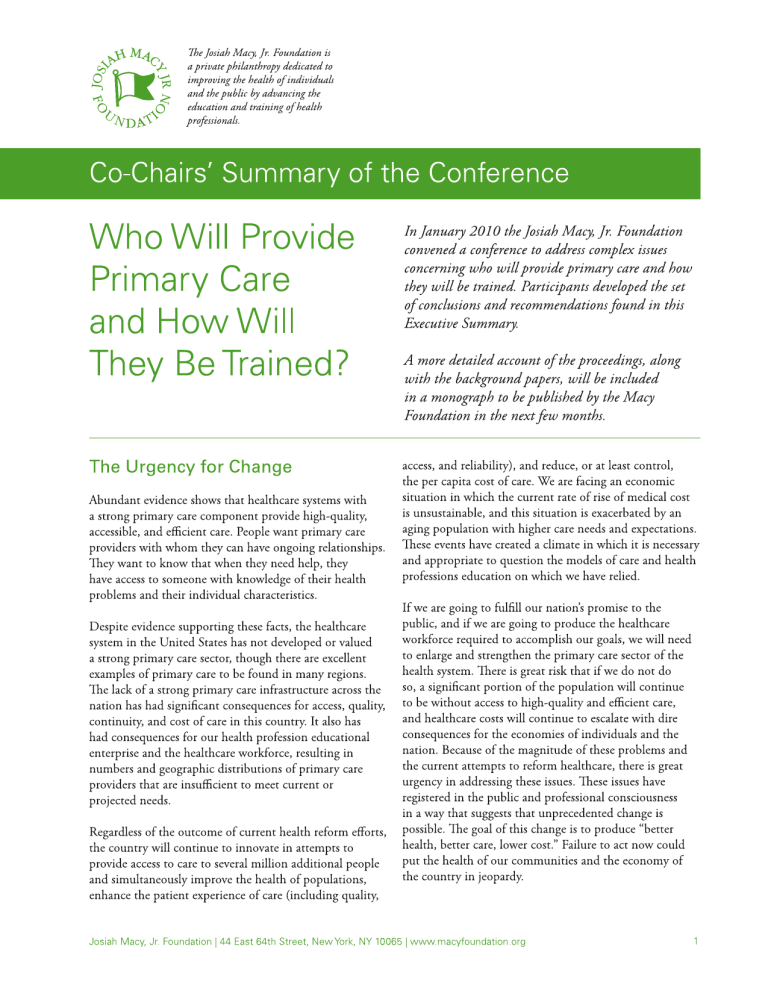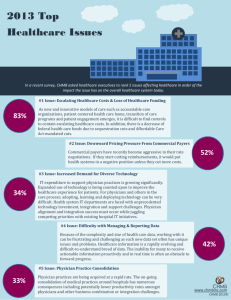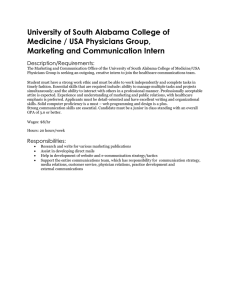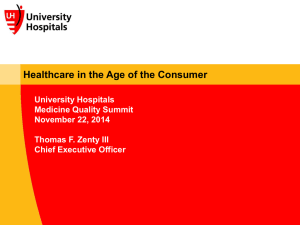Document 11995092

In January 2010, the Josiah Macy, Jr. Foundation convened a conference entitled “Who Will Provide
Primary Care and How Will They Be Trained?”
Held at the Washington Duke Inn in Durham,
North Carolina, the conference was co-chaired by
Linda Cronenwett, Ph.D., R.N., FAAN, Professor and Dean Emeritus, School of Nursing, University of North Carolina at Chapel Hill and Victor J.
Dzau, M.D., James B. Duke Professor of Medicine,
Chancellor for Health Affairs of Duke University and Chief Executive Officer of the Duke University
Health System. Attending this important meeting were 49 participants, carefully chosen to represent a diversity of views on primary care, including experts from all professional groups who provide primary care (allopathic and osteopathic physicians, nurse practitioners, and physician assistants) and experts from the various sectors affected by the challenges related to primary care (consumers, academia, practice, science, journalism, government, healthcare policy, payors, and foundations).
Participants arrived in Durham well prepared to discuss the background papers (included in a forthcoming monograph). For each session topic, the list of people contributing insights was impressive.
Many conversations continued well into the evenings.
Perhaps the most noteworthy observation was the encouraging consensus that emerged among leaders from different parts of the healthcare system—a general agreement about what needs to be done; a willingness to come together to accomplish goals that will benefit patients, families, communities, and health professionals; and a sense of urgency to bring about major changes that will strengthen primary care in our country.
We began our discussions with a review of the history of primary care and our relative lack of investment in population health (included in the definitions of primary healthcare in most of the rest of the world).
When Abraham Flexner put medical education on a scientific footing with his 1910 report, medical education as we know it was created. Medical schools were associated with large teaching hospitals, and highly knowledgeable specialists directed departments organized around organ systems. When the National
Institutes of Health were formed, these faculties focused on the creation of yet more specialized knowledge. Healthcare payment structures responded to the technologies and science of these specialists, resulting in the healthcare practices we invest in today. As specialty medicine grew in prestige and reimbursement, general internal medicine, general pediatrics, and the more recent specialty of family medicine took a lower place in the hierarchy, reaching the point today in which a medical student who chooses a primary care specialty does so with the knowledge that he or she is leaving substantial dollars of lifetime income on the table.
During this same period, and often in response to shortages of primary care allopathic physicians, the numbers of osteopathic physicians, primary care advanced practice nurses (nurse midwives and nurse practitioners), and physician assistants grew.
Each group was trained initially within disciplinary silos, with an emphasis on primary care. Gradually, options for specialist careers in medicine emerged for osteopathic physicians, and the percentage of osteopathic graduates choosing primary care careers diminished. Physician assistants tend to practice where physicians practice. For the most part, therefore, the number of physician assistants in primary care has diminished in accordance with physician practice patterns. Nurse practitioners proved effective in primary care roles, but regulatory and reimbursement policy barriers often prevented efficient and effective use of their services. In many states, such barriers exist to this day.
Meeting participants were enthusiastic about many innovations in primary care today— experiments that use teams of primary care providers; electronic health records and other technologies; and other health professionals in systems of care that meet patient and community needs. But they recognized that these environments were relatively few and far between. Early in our discussions, it became clear that participants believed it would be difficult to alter the downward trajectory of recruitment and retention of primary care physicians, in particular, without significant reforms in reimbursement and care delivery models. Also important is training the next generation of primary care providers within these innovative primary care practice settings, both within and beyond academic health centers. Participants were unanimous in their views that trainees need exposure to effective teams, working within systems that are designed to meet the needs of patients and communities, in order to learn about working in a team-based environment and to appreciate the rich rewards associated with primary care careers.
To ensure these learning environments across the nation, some type of payment reform that
2
Participants were unanimous in their views that trainees need exposure to effective teams, working within systems that are designed to meet the needs of patients and communities, in order to learn about working in a team-based environment and to appreciate the rich rewards associated with primary care careers.
provides incentives for investment in primary care infrastructures, technologies, and salaries is essential.
Frequently, primary care providers are expected to develop the technological and personnel infrastructures necessary to meet the holistic needs of their patients and communities out of their practice incomes.
Participants emphasized repeatedly that a call for greater investment in primary care was not a call for a greater expense in healthcare overall. In numerous studies, the benefits of investments in primary care are clear—overall healthcare costs per capita decline.
Without reformed payment structures, however, the frustrations of not being able to meet all expectations become overwhelming, and the inevitable result is a decline in numbers of people choosing primary care careers. The bottom line is this: unless trainees from all provider groups witness care being delivered by effective and efficient teams of primary care professionals who have the infrastructures to enable patients, families, and communities to achieve goals for individual and population health, the country will produce fewer and fewer primary care providers and will be unlikely to achieve its goals of reducing overall costs of care while improving healthcare quality and access. should deliver primary care and how should the primary care practitioners of the future be trained?
As co-chairs, we were gratified to achieve a remarkable consensus on many issues of substance related to these questions, particularly the idea that all health professionals need training that ensures they have the skills to lead and work effectively in teams, to represent the interests of the public in ensuring a strong primary care infrastructure, and to expect, within their careers, to assume their share of accountability for continuously improving access to care, care coordination, costs of care, and quality of outcomes related to individual and population health. Health professionals need to develop attitudes that welcome patients as partners in care, moving beyond the current model of intermittent, facility-based contacts. And they need experience with the use of new tools, such as information technology; online monitoring and assessment; and supports for self care, home-based care, and virtual tele-health interactions, all of which will be part of primary care in the future. These overarching themes led directly to recommendations designed to improve the training of all primary care providers.
Within this context, participants struggled with whether or not they could address the issues associated with what is referred to broadly as primary healthcare.
There was a strong desire to address the broader needs of populations—needs that affect health but derive from a community’s access, not only to healthcare, but to systems designed to support other public health, social, and educational needs. The participants considered the possibilities of new forms of primary care, through which society might hold healthcare systems accountable for both individual and population health goals. However, in order to have recommendations of substance that could change outcomes in the foreseeable future, participants decided to focus on the central questions posed to them at the start of the conference: namely, who
We left the conference inspired by the passion and commitment of the participants and with the development of a consensus that would move us toward a preferred future—a future in which our society’s needs for primary care would be met effectively. It is our distinct privilege to have co-chaired this important meeting and to share with you the conference conclusions and recommendations.
3
4
Conclusions and Recommendations
CONCLUSION I
In order to meet societal needs for primary care and train the right primary care professionals in the right numbers with the right competencies for the most appropriate roles, healthcare systems need incentives to dramatically change the way primary care is valued, delivered, and integrated in evolving healthcare systems.
We will not attract and retain sufficient numbers nor achieve the needed geographic distribution of primary care providers unless there is a greater proportional investment in primary care. Our students and trainees must be educated throughout their clinical training in practices that deliver first-contact, comprehensive, integrated, coordinated, high-quality, and affordable care. These practices require teams of professionals who give care that elicits patient and provider satisfaction under conditions of clearly defined roles, effective teamwork, patient engagement, and transparency of outcomes.
Recommendation 1 barriers that make it difficult for nurse practitioners and physician assistants to serve as primary care providers and leaders of patient-centered medical homes or other models of primary care delivery. All primary care providers should be held accountable for the quality and efficiency of care as measured by patient outcomes.
Recommendation 3
Promote stronger ties between academic health centers and other primary care sites and the communities they serve, setting goals and standards for accountability for primary prevention as well as individual and population health. All health systems, including the primary care practices embedded within them, should be accountable for quality and cost outcomes through well-tested, nationally recognized metrics that address the needs of populations and individuals, with data that are transparent and that can be used for the continuous improvement of models of care.
Recommendation 4
Create financial and other incentives for the development of innovative models of primary care and the advancement of knowledge about outcomes that allow us to identify best practices in the achievement of high-value primary care. Strategies may include the following:
• A competitive process for the establishment of
Centers of Excellence in Primary Care
• Mechanisms that analyze and better define the roles of various health professionals in best- practice, highvalue primary care models
• Development and improvement of national metrics for assessment of patient and population health
• Mechanisms for the diffusion of knowledge about best practices, such as the proposed Primary Care
Extension Program.
Recommendation 2
Coupled with efforts to increase the number of physicians, nurse practitioners, and physician assistants in primary care, state and national legal, regulatory, and reimbursement policies should be changed to remove
Invest in primary care health information technologies that support data sharing, quality improvement, patient engagement, and clinical care, with the aim of continuously improving the health and productivity of individuals and populations.
Recommendation 5
Recognizing that current payment systems create incentives for underinvesting in primary care services, implement all-payor payment reforms that more appropriately recognize the value contributed by primary care through such mechanisms as global payments linked to patient complexity and accountability for the provision of healthcare services, including preventive services, care coordination across settings, chronic disease management, and 24/7 accessibility. Improved costs and quality of health outcomes for patients and populations should be rewarded. In addition, implement legislation that will standardize insurance reimbursement reporting requirements to reduce administrative costs inherent in a multi-payor system.
CONCLUSION II
In addition to the critical challenges outlined above in the organization and financing of healthcare, current health professional educational models are generally inadequate to attract, nurture, and train the primary care workforce of the future.
• Implementing special primary care tracks for students and trainees.
• Establishing and strengthening departments of family medicine within schools of medicine.
Recommendation 3
Recommendation 1
Create incentives for innovative projects in health professions education, enlisting funding partners from government, industry, philanthropy, and payors in order to develop models of excellent, high-performing, and advanced interprofessional primary care.
Interprofessional education should be a required and supported part of all health professional education.
This change is especially important for primary care.
Regulatory, accreditation, reimbursement, and other barriers that limit members of the healthcare team from learning or working together should be eliminated.
Recommendation 4
Academic health centers, working with teaching community health centers, area health education centers
(AHECs), and other training sites are the logical entities to advance such innovations. Strategies could include the development of Primary Care Translational Centers of Excellence that would perform primary care research and evaluation and provide team-based education, with emphasis on the study of new models of primary care and health delivery transformation.
Recommendation 2
Medical schools, nursing schools, and other schools for the health professions, which hold the societal responsibility for the education of health professionals, have an opportunity and obligation to increase the size and strength of the primary care workforce. Leaders of health professional schools should implement actions known to increase the number of students and trainees choosing careers in primary care. These actions include the following:
• Establishing programs to prepare and attract a more socioeconomically, racially, and geographically diverse student body
• Revising admission standards to include more emphasis on social science and humanities and the personal qualities of applicants
• Implementing and expanding scholarship and loan repayment programs in partnership with health systems, governmental agencies, and communities for those pursuing careers in primary care
• Promoting early exposure to primary care practices for all students
• Creating longitudinal immersion clinical experiences in community primary care settings
The Department of Health and Human Services, through its appropriate agencies and divisions, should be granted additional funding to support interprofessional training, preparation of the primary care workforce, and leadership development programs to produce clinicians to take the lead in new models of primary care. Strategies to accomplish these goals could include the following:
• Expansion of Title VII and Title VIII funding and authority to jointly fund interprofessional programs
• Expansion of Title VII and Title VIII funding to address faculty shortage and educational underinvestment in the development of faculty for primary care
• Increase in AHEC funding to expand its pipeline programs in primary care and to provide community-based, interprofessional educational experiences for all primary care health professions students
• Resumption of the Primary Care Health Policy
Fellowship and creation of new programs to prepare clinician-leaders for new models of practice
• Provision of adequate scholarships and loan repayment programs to provide clinicians to underserved areas and to improve diversity
• Expansion and direction of funding for graduate medical, nursing, and physician assistant educational programs (Medicare Graduate Medical Education funding, Title VII, Title VIII) to support trainees and training infrastructure costs in ambulatory settings, including teaching community health centers, AHECs, academic outpatient clinics, and other community-based programs.
5
CONCLUSION III
Recognizing that the healthcare system is dynamic and will continue to evolve, strong leadership will be needed to advance the science, teaching, practice, and policy development relevant to primary care.
Recommendation 1
This report is in the public domain and may be reproduced or copied without permission.
Citation, however, is appreciated.
Cronenwett L & Dzau V. Chairman’s Summary of the
Conference. In: Culliton B, editor. Who Will Provide
Primary Care and How Will They Be Trained?, 2010;
Durham, NC. Josiah Macy, Jr. Foundation; 2010.
Develop leaders with a focus on advancing the curricula and learning opportunities for preparing competent primary care clinicians, scientists, and policymakers of the future.
Medical, nursing, and other health profession school faculties should form partnerships with educators from other disciplines, such as business and law, to develop novel educational opportunities for advancing primary care leadership, research, policy, and advocacy.
As a routine part of their education, primary care students should be exposed to mentored opportunities to participate in healthcare improvement and policy development and to function within interprofessional and interdisciplinary leadership teams.
Recommendation 2
Support the further development of science and the scientific leadership necessary to advance the translation of best practices into primary care delivery for the improvement of patient and community health.
Initiatives could include the following:
• Funding career development for scientists that can create improved national metrics for assessment of individual and population health
• Providing targeted funding through Clinical
Translational Science Awards, National Research
Service Awards, and Health Research Services
Awards for scientists focused on primary care
• Developing a national healthcare workforce analysis and policy capability for ensuring an adequate and well-prepared primary care workforce over time.
Recommendation 3
Recognize the need to include representatives of all primary care providers in the leadership of delivery systems and in groups that are responsible for developing healthcare policies at the state and federal level.
6
Conference Participants
Linda Cronenwett,
Ph.D., R.N., FAAN*
University of North Carolina at Chapel Hill
School of Nursing
Co-Chair
Victor J. Dzau, M.D.*
Duke University
Duke University Health System
Co-Chair
Ruth Ballweg, M.P.A., P.A.-C.
MEDEX Northwest Division of
Physician Assistant Studies
University of Washington School of Medicine
Richard J. Baron, M.D., FACP
American Board of Internal Medicine Foundation
Greenhouse Internists, PC
Michael S. Barr,
M.D., M.B.A., FACP
American College of Physicians
Bobbie Berkowitz,
Ph.D., R.N., FAAN
University of Washington
School of Nursing
JudyAnn Bigby, M.D.
Massachusetts Executive Office of Health and Human Services
Robert H. Brook,
M.D., Sc.D., FACP
RAND Health
Darwin Brown, P.A.-C., M.P.H.
University of Nebraska Medical Center
Physician Assistant Program
Jordan J. Cohen, M.D.
The George Washington University
Medical Center
Gerald Cross, M.D.
Department of Veterans Affairs





